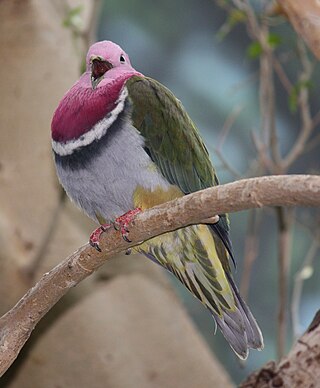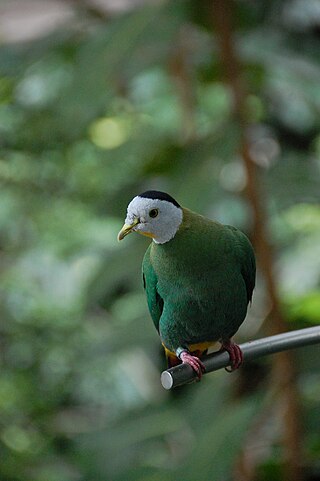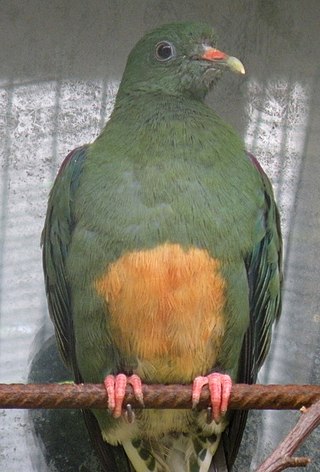
The superb fruit dove, also known as the purple-crowned fruit dove, is a medium-sized, colourful fruit-dove in the family Columbidae.

The pink-headed fruit dove also known as pink-necked fruit dove or Temminck's fruit pigeon, is a small colourful dove.

The jambu fruit dove is a smallish colourful fruit dove. It is a resident breeding species in southern Thailand, Malaysia, Brunei and the Indonesian islands of Kalimantan, Sumatra and Java.

The whistling fruit dove, also known as the velvet dove or yellow-headed dove, is a small fruit dove from Fiji. The species is endemic to the islands of Kadavu and Ono in the Kadavu Group in the south of Fiji.

The black-naped fruit dove, also known as the black-headed fruit dove, is a medium-sized, up to 24 cm (9.4 in) long, green fruit dove with yellowish bill and iris. The male has a pale grey head with a black nape, yellow throat, and golden yellow and pink undertail coverts. The plumage of the female and the young is entirely green.

Wallace's fruit dove is a species of bird in the pigeon family Columbidae. The name commemorates the British naturalist Alfred Russel Wallace. It is a rather large, long-tailed fruit dove with a length of 24–28 cm (9.4–11.0 in) and has been described as "one of the most beautiful" fruit doves. The forehead and crown are dull crimson, the lower face and throat are white, and the rest of the head, breast, neck, and upper back are pale bluish-grey. The wings and lower back are green and the belly is orange, separated from the chest by a white band. Both sexes look similar, but females have less extensive red on the head and a greenish tinge to their grey parts.

The orange fruit dove is a species of bird in the pigeon family Columbidae. One of the most colorful doves, the male has a golden olive head and elongated bright orange "hair-like" body feathers. The golden-olive remiges are typically covered by the long orange wing coverts when perched. The legs, bill and orbital skin are bluish-green and the iris is whitish. The female is a dark green bird with blackish tail and orange-yellow undertail coverts. The young resemble females.

The golden fruit dove, also known as the lemon dove or yellow dove, is a small, approximately 20 cm (8 in) long, short-tailed fruit-dove in the family Columbidae. The common name refers to the males' bright golden-yellow colour. The body feathers appear almost iridescent due to their elongated shape and hair-like texture. The head is slightly duller with a greenish tinge. The bill, orbital skin and legs are bluish-green and the iris is whitish. The underwings and tail coverts are yellow. The female is a dark green bird with bare parts resembling those of the male. The young resembles the female.

The orange-bellied fruit dove is a small pigeon with mainly green plumage, distinguished by a large orange patch on the lower breast and belly, a small lilac shoulder patch, pale yellow undertail coverts, and a grey terminal band on the tail.

Edwards's fig parrot, also known as the scarlet-cheeked fig parrot, is a species of parrot in the family Psittaculidae found in humid lowland forests in north-eastern New Guinea. The adult male is predominantly green with red breast and cheeks, yellow ear coverts, and yellowish crown.

Mountain pigeons are four species of birds in the genus Gymnophaps in the pigeon family Columbidae. They are found on islands in eastern Indonesia and Melanesia, where they inhabit hill and montane forest. Medium-sized pigeons with long tails and wings, they are 33–38.5 cm (13.0–15.2 in) long and weigh 259–385 g (9.1–13.6 oz). They mostly have dull grey, white, or chestnut-brown plumage, their most distinctive feature being bright red skin around the eyes. Males and females mostly look alike, but the Papuan and pale mountain pigeons show slight sexual dimorphism. Mountain pigeons are very social and are usually seen in flocks of 10–40 birds, although some species can form flocks of more than 100 individuals. They are generally quiet and do not make many vocalisations apart from a distinctive whooshing noise while leaving their high-altitude roosts to feed in the morning.

The Negros fruit dove is a species of bird in the pigeon and dove family, Columbidae. It is endemic to the island of Negros in the Philippines. This fruit dove is known from a single female specimen collected from the slopes of Mount Kanlaon in the northern part of the island. While it was found at a high elevation, it is suspected that the species originally lived in the lowland dipterocarp forests and was driven to higher elevations by habitat destruction. While some have suggested that the specimen is either a runt or a hybrid instead of a valid species, this is not widely accepted. The female Negros fruit dove was a small fruit dove with vivid dark green plumage and an ashy-grey forehead. It had a distinctive ring of bare yellow skin around its eye, and yellow fringes to some of its feathers gave it the appearance of having a yellow wingbar when perched. The throat was white, while the undertail and vent were yellow.

The white-headed fruit dove is a species of bird in the pigeon family Columbidae. It was described by the English ornithologist John Gould in 1856, and the specific name eugeniae honours the French empress Eugénie de Montijo. Adults of the species have white heads, a purplish-red breast patch, a grey shoulder patch, olive-green upperparts, greenish underparts with a blue tinge, and a yellowish vent. Juveniles have green heads with the white restricted to the forehead and upper throat, a much smaller grey shoulder patch, and the red breast patch restricted to the centre of the breast.

The red-moustached fruit dove is an extinct species of bird in the family Columbidae. It was endemic to French Polynesia. The last record was of the subspecies P. m. tristrami on Hiva Oa, in 1922. Its extinction has been attributed to predation by the introduced great horned owl, as well as by introduced rats and cats. In 1994, it was listed as an extinct species on the International Union for Conservation of Nature Red List of Endangered Species.

The many-colored fruit dove, also known as manuma in the Samoan language, is a species of bird in the family Columbidae. It occurs on islands in the south-west Pacific Ocean where it is found in Fiji, the Samoan Islands, and Tonga. Its natural habitat is subtropical or tropical moist lowland forests. Today, the birds are most often found in Fiji and Tonga. It usually feeds high in the canopy on fruit and berries, especially banyan fig. The nest is a small platform of twigs where one white egg is laid.

The white-bibbed fruit dove is a species of bird in the family Columbidae.

The claret-breasted fruit dove is a species of bird in the family Columbidae. It is found in the Moluccas, New Guinea and the Solomon Islands archipelago. Its natural habitat is subtropical or tropical moist lowland forests.

The pin-tailed green pigeon is a species of bird in the family Columbidae native to Southeast Asia.

The black-capped tanager is one of the many species of Neotropical bird in the family Thraupidae. It lives in mountains of Ecuador, Colombia and Venezuela year-round. This bird can often be found in open landscapes, alone or in pairs, hiding under branches of trees and bushes. Its natural habitats are subtropical or tropical moist montane forests and heavily degraded former forest.

The fruit doves, also known as fruit pigeons, are a genus (Ptilinopus) of birds in the pigeon and dove family (Columbidae). These colourful, frugivorous doves are found in forests and woodlands in Southeast Asia and Oceania. It is a large genus with over 50 species, some threatened or already extinct.





















